Unit - 1
Integral calculus-I
The beta and gamma functions are defined as-

And

These integrals are also known as first and second Eulerian integrals.
Note- Beta function is symmetrical with respect to m and n.

Some important results-
Ex.1: Evaluate dx
dx
Solution dx =
dx =  dx
dx
= γ(5/2)
= γ(3/2+ 1)
= 3/2 γ(3/2 )
= 3/2. ½ γ(½ )
= 3/2. ½ π
= ¾ π
Ex. 2: Find γ(-½)
Solution: (-½) + 1= ½
γ(-1/2) = γ(-½ + 1) / (-½)
= - 2 γ(1/2 )
= - 2 π
Ex. 3. Show that 

Solution:
 =
= 

= 


= 


 ) .......................
) .......................
= 

= 


Ex. 4: Evaluate 
 dx.
dx.
Solution: Let 

 dx
dx
Put  or
or  ;dx =2t dt
;dx =2t dt
X | 0 |  |
t | 0 |  |
 dt
dt
 dt
dt



Ex. 5: Evaluate  dx.
dx.
Solution: Let 
 dx.
dx.
Put  or
or  ; 4x dx = dt
; 4x dx = dt
x | 0 |  |
t | 0 |  |
 dx
dx




Evaluation of beta function 𝛃 (m, n)-

Here we have-


Or

Again integrate by parts, we get-

Repeating the process above, integrating by parts we get-

Or

Evaluation of gamma function-


Integrating by parts, we take  as first function-
as first function-





We get-


Replace n by n+1,

Relation between beta and gamma functions
Relation between beta and gamma function-
We know that-

 ………… (1)
………… (1)
 …………………..(2)
…………………..(2)
Multiply equation (1) by  , we get-
, we get-

Integrate both sides with respect to x within limits x = 0 to x =  , we get-
, we get-

But

By putting λ = 1 + y and n = m + n
We get by using this result in (2)-
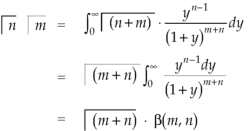
So that-

Definition: Beta function

Properties of Beta function:
Example(1): Evaluate I = 
Solution:







= 2 π/3
Example(2): Evaluate: I = 02 x2 / (2 – x ) . Dx
Solution:
Letting x = 2y, we get
I = (8/2) 01 y2 (1 – y ) -1/2dy
= (8/2). B (3, 1/2 )
= 642 /15
Evaluation of integrals
1. 

 by using beta and gamma functions-
by using beta and gamma functions-
Evaluation of the first interal-

Evaluation of the second integral-

Example: Prove that-

Where a>0.
Sol.
We know that-

Put m – 1 = 1 or m = 2
We get-


Hence proved
Relation between Beta and Gamma functions:


Example(1): Evaluate: I = 0a x4 (a2 – x2 ) . Dx
Solution: Letting x2 = a2 y , we get
I = (a6 / 2) 01 y 3/2 (1 – y )1/2dy
= (a6 / 2) . B(5/2 , 3/2 )
= a6 /3 2
Example(2): Evaluate: I = 02 x (8 – x3 ) . Dx
Solution: Let x3 = 8y
I = (8/3) 01 y-1/3 (1 – y ) 1/3 . Dy
= (8/3) B(2/3 , 4/3 )
= 16 π / ( 9 3 )
Example(3): Prove that
Solution: Let

Put or
or  ,
, 







Example(4): Evaluate
Solution: Let
Put  or
or  ,
,
 ,
,
When ,
, ;
; ,
,
 | o |  |
 | 1 | 0 |












Example(5): Show that
Solution:
=



 (
( 0<p<1)
0<p<1)



 (by above result)
(by above result) 

Elliptic integral-
The integral  is called elliptic function.
is called elliptic function.
This is derived from the determination of the perimeter of the ellipse.
To evaluate this integral, we first expand the integrand  as power series and then integrate term by term.
as power series and then integrate term by term.
Elliptic integral of first kind

Elliptic integral of second kind

Here k is modulus and  is amplitude.
is amplitude.
Jacobi’s form of elliptic integrals


Example: Express  in terms of elliptic integral.
in terms of elliptic integral.
Sol.
Here we have-


Put 
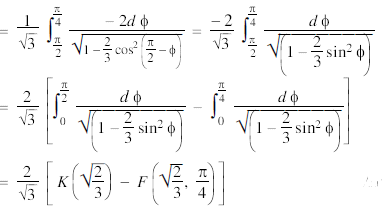
Error function-
Error function of x is written as erf(x) and defined as below-

The complementary function of error function of x is written as  and defined as below-
and defined as below-

Note-

Example: Find erf(0).
Sol.
We know that-

Then

Hence-

Example: Prove that erf (-x) = - erf (x)
Sol.
We know that-


Put t = -u

Key takeaways-
- The integral
 is called elliptic function.
is called elliptic function. - Elliptic integral of first kind

3. Elliptic integral of second kind

4. Jacobi’s form of elliptic integrals


5. 
6. 
7. 
8. 
9. 
10. 
11. 
Differentiation under integral sign: Leibnitz’s rule:
We know from the fundamental theorem on integral calculus that if f (x) is a continuous function and

Then

i.e., the derivative of a definite integral w.r.t. The upper
Limit is equal to the integrand in which the variable of integration t is replaced by the upper limit ‘x’
Differentiating integrals depend on a parameter:
Consider the definite integral:

In which the integrand f (x, α) is dependent on a parameter α. The value of the definite integral (2) changes as the parameter α varies. It is difficult to integrate (2) in many cases.
Now to differentiate the integral (2) w.r.t. The parameter α, without having to first carry out integration and then differentiation, we use the Leibnitz’s rule.
Leibnitz’s formula (rule):
If  are continuous functions when c
are continuous functions when c  and a
and a 

General Leibnitz’s rule:
If  and
and  are continuous and if the limits of integration a and b are functions of
are continuous and if the limits of integration a and b are functions of  then
then
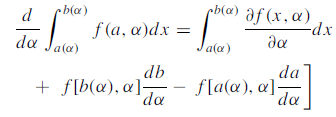
Example: Apply Leibnitz’s rule

Sol: here



Now applying Leibnitz’s rule
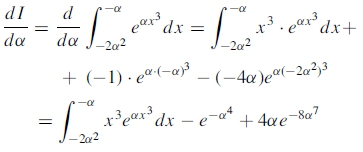
We know that the voltages and current vary with time and if we are interested to find the mean value of current or voltage over some particular time interval. We define the mean value of a function in terms of an integral.
An associated quantity is the root-mean-square.
Average value of a function:
Suppose a time-varying function f(t) is defined on the interval  . The area, A, under the graph of f(t) is given by the integral A
. The area, A, under the graph of f(t) is given by the integral A

Illustration of this is given in the figure below:
- The area under the curve from t = a to t = b
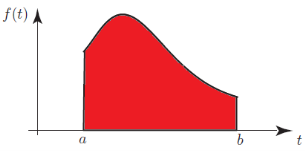
2. The area under the curve and the area of the rectangle are equal



The value of m is the mean value of the function across the interval 
Note-
The mean value of a function f(t) in the interval 

The mean value depends upon the interval chosen. If the values of a or b are changed, then the
Mean value of the function across the interval from a to b will in general change as well.
Example: Find the mean value of f(t) =  over the interval
over the interval 
Sol:
As we know that

Here
a = 1 and b = 3 and f(t) = 


Root-mean-square-value of a function
If f(t) is defined on the interval  , the mean-square value is given by the expression:
, the mean-square value is given by the expression:

This is simply the mean value of  over the given interval.
over the given interval.
The related quantity: the root-mean-square (r.m.s.) value is given by the following formula.

The r.m.s. Value depends upon the interval chosen. If the values of a or b are changed, then the r.m.s. Value of the function across the interval from a to b will in general change as well. Note that when finding an r.m.s. Value the function must be squared before it is integrated.
Example: Find the r.m.s. Value of f(t) =  across the interval from t = 1 to t = 3.
across the interval from t = 1 to t = 3.
Sol:
We know that


Example: Find the r.m.s value of f(t) = sin t across the interval 
Sol:
Here a = 0 and b = 2_ so r.m.s can be calculated as,


Note- 

References:
1. Higher Engineering Mathematics: B. S. Grewal
2. Applied Mathematics Volume I & II: J. N. Wartikar
3. Textbook of Engineering Mathematics: Bali, Iyenger (Laxmi Prakashan)





